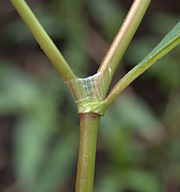| Line 82: | Line 82: | ||
===Bellflower=== | ===Bellflower=== | ||
| + | The Bellflower family consists mostly of herbs, shrubs, and more rarely small trees, which usually have milky non-toxic sap. Leaves of these species are often alternate, more rarely opposite. They are also simple and without stipules. Flowers are bisexual, bell-shape, consisting of a narrow tube-like corolla with small spreading lobes. Flowers are fairly often blue. Fruits are often berries, but can also be capsules. | ||
| + | * Bluebell | ||
| + | * Harebell | ||
| + | * Lobelia | ||
| + | * Balloonflower | ||
| + | |||
===Mint=== | ===Mint=== | ||
===Aster (Daisy)=== | ===Aster (Daisy)=== | ||
===Snapdragon=== | ===Snapdragon=== | ||
Revision as of 02:35, 1 August 2007
Lily
- Turk's Cap Lily
- Wild Garlic
- Onion
- Trillium
- Fawn Lily
- Tulip
- Hyacinth
Mustard
- Cabbage
- Broccoli
- Cauliflower
- Brussels sprouts
- Mustard
- Horseradish
- Watercress
Pink
- Swamp Milkweed
- Common Milkweed
- Butterfly Plant
- Sand Milkweed
- Whorled Milkweed
Buttercup
- Columbine
- Marsh Marigold
- Thimbleweed
- Clematis
- Hellbore
- Larkspur
- Buttercup
Cactus
- Saguaro
- Barrel Cactus
- Prickly Pear
- Rabbit Ear
Rose
Members of the Rose family have 5 sepals and 5 petals which are flat and wavy at the margins. Each flower has at least ten stamens. All members of the rose family have a hypanthium, which is a bowl-shaped part of a flower consisting of the bottoms of the sepals, petals, and stamens stuck together.
- Rose
- Apple
- Blackberry
- Strawberry
- Raspberry
- Apple
- Plum
- Peach
- Cherry
- Pear
Bean
All members of this family have five-petaled flowers in which the superior ovary ripens to form a "pod", technically called a legume, whose two sides split apart, releasing the seeds which are attached to one or both seams. A significant characteristic of legumes is that they host bacteria in their roots, within structures called root nodules. These bacteria have the ability to take nitrogen gas out of the air and convert it to a form of nitrogen that is usable to the host plant. This process is called nitrogen fixation.
- Bean
- Lupins
- Clover
- Alfalfa
- Peas
- Peanuts
- Soybeans
- Lentils
- Mimosa
- Kudzu
Parsley
The parsley family has flower clusters being in the form of a compound "umbel". The small flowers are radially symmetrical with 5 small sepals, 5 petals and 5 stamens.
- Cumin
- Parsley
- Carrot (Queen Anne's Lace)
- Dill
- Caraway
- Fennel
- Angelica
Smartweed
The seeds of the plants belonging to the smartweed family have a triangular shape. Leaves of these plants have a peculiar pair of sheathing stipules known as ocreae.
- Buckwheat
- Sorrel
- Rhubarb
- Knotgrass
Bellflower
The Bellflower family consists mostly of herbs, shrubs, and more rarely small trees, which usually have milky non-toxic sap. Leaves of these species are often alternate, more rarely opposite. They are also simple and without stipules. Flowers are bisexual, bell-shape, consisting of a narrow tube-like corolla with small spreading lobes. Flowers are fairly often blue. Fruits are often berries, but can also be capsules.
- Bluebell
- Harebell
- Lobelia
- Balloonflower

